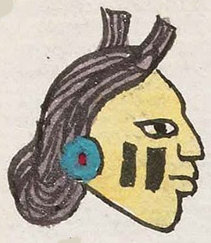Cihuatlan (Mdz38r)
The compound glyph for cihuatl) (woman) serves to identify the full town name, Cihuatlan. The -tlan locative is not presented visually. The cihuatl consists only of a woman's head in profile, lookin go the viewer's right, with her hair worn in the traditional style for an adult woman (a style called the neaxtlahualli). She has two parallel, black, hash marks on her cheek. In her ear lobe is an earplug probably made of turquoise. Her hair is wrapped up with two points at the top of her head. The hair has a purple watercolor wash over it, probably meaning to suggest her hair is black. Her skin tone is light, almost tan or pale yellow.
Stephanie Wood
The the two vertical, parallel black lines that appear on the woman's cheek add a phonetic reinforcement to the reading of cihuatl), underlining the "hua" syllable. They might be compared to the lines on the cheek of the goddess Chicomecoatl (from the Tonalamatl Aubin, plate 7, published in an article by Élodie Dupey García in Mexicolore). But, the meaning of the parallel lines has yet to be identified fully. Note the similar parallel lines on the side of a canoe in the place name for Acalhuacan, pointing to the -hua- element. And note the parallel lines on the side of a xicalli in the place name for Xicalhuacan. While this came to our attention independently, Danièle Dehouve (2018) also noticed this phenomenon.
There is a municipality called Cihuatlan in the contemporary state of Jalisco.
Stephanie Wood
çihuatlan. puo
Cihuatlan, pueblo
Stephanie Wood
c. 1541, or by 1553 at the latest
Stephanie Wood
This is a simplex standing in for a compound, so there is no reading beyond the one sign, cihuatl (woman).
double-strike sign, double-stroke sign, women, woman, mujeres, face paint, nombres de lugares, axtlacuilli

cihua(tl) (woman), https://nahuatl.wired-humanities.org/content/cihuatl
-tlan (locative), https://nahuatl.wired-humanities.org/content/tlan
neaxtlahual(li), a certain hairstyle for sedentary women, https://nahuatl.wired-humanities.org/content/neaxtlahualli
"Woman Place" (here, Karttunen reads cihuatl as singular; also, she sees the locative suffix as -tlan, place, and not -tla or -tlah, which would have provided the sense of many or abundance; note how the gloss image supports the reading of -tlan) [Frances Karttunen, unpublished manuscript, used here with her permission.]
"Place of Many Women" (Berdan and Anawalt, 1992, vol. 1, p. 185)
Codex Mendoza, folio 38 recto, https://digital.bodleian.ox.ac.uk/objects/2fea788e-2aa2-4f08-b6d9-648c00..., image 86 of 188.
The Bodleian Libraries, University of Oxford, hold the original manuscript, the MS. Arch. Selden. A. 1. This image is published here under the UK Creative Commons, “Attribution-NonCommercial-ShareAlike 3.0 License” (CC-BY-NC-SA 3.0).

